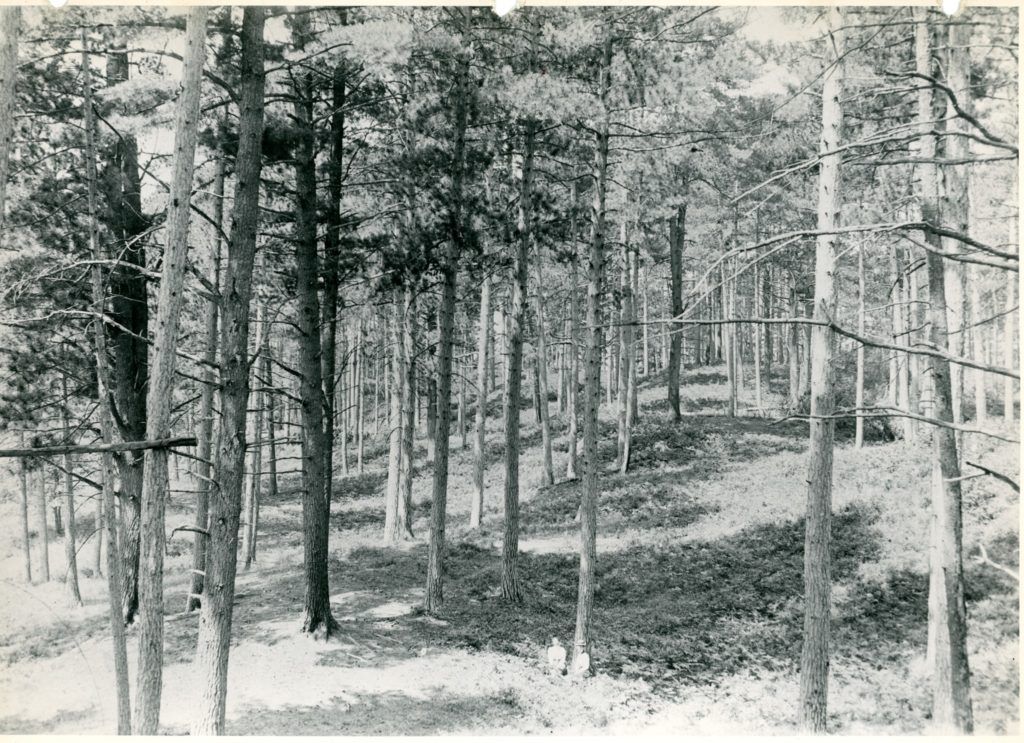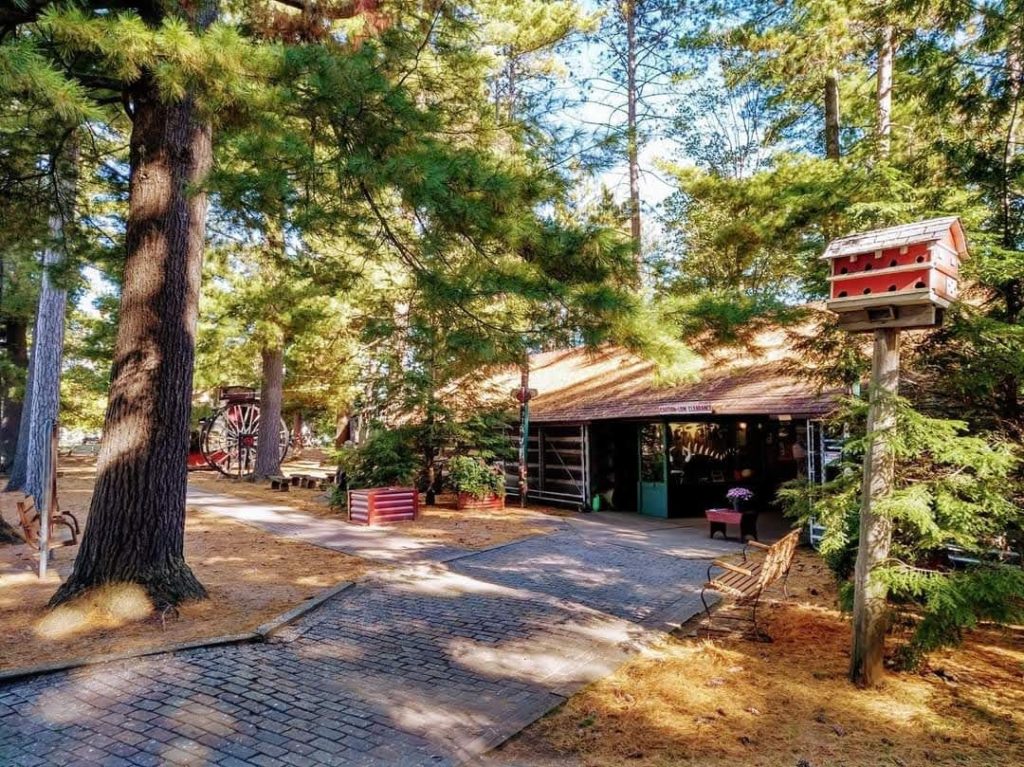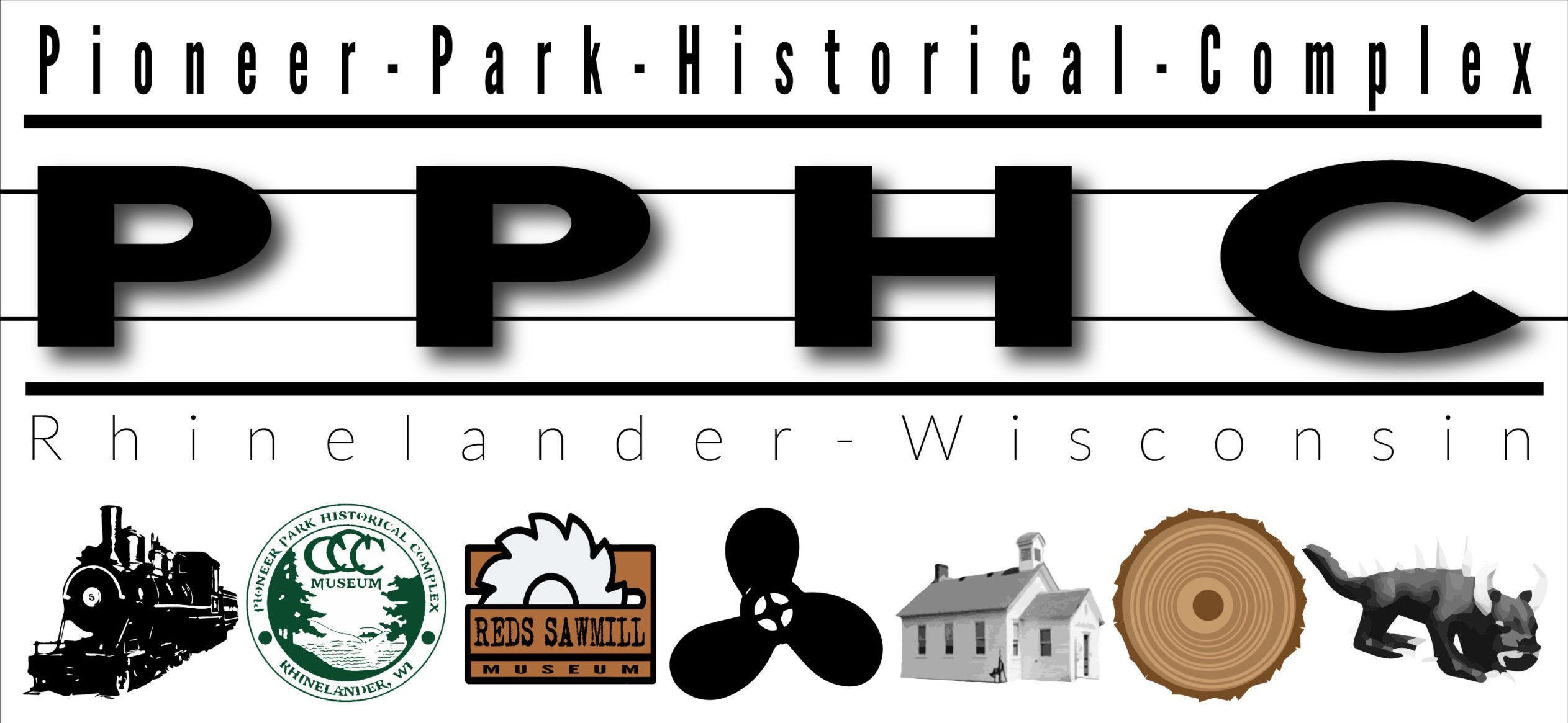What follows is an in-depth write up on the history of Pioneer Park as a whole.

Pioneer Park Historical Complex, also called Rhinelander Logging Museum, Rhinelander Schoolhouse Museum is a combination open-air museum of historical structures in Rhinelander, Wisconsin, United States. It is listed as a city park, managed by a non-profit organizations. The structures include log cabins from the fur trade era, buildings from and stores and public buildings from the late nineteenth century.[1]
The museum houses displays related to the Hodag, a fictional animal photographed and distributed in 1896 by Eugune Sheppard. The character has become the mascot associated with Rhinelander.[2]
Pioneer Park has seen many changes over the decades since it was developed into a city park, and has been a popular destination for Rhinelander residents and visitors to the area for many years. Like much of Rhinelander history, the stories behind Pioneer Park are intertwined with many of the most prominent aspects of Rhinelander’s earliest moments, and tells a story of not just a park, but the founding of the city itself.
In the 1870’s when young Anderson Brown from Stevens Point made his way up the mighty Wisconsin River to cruise a potential purchase of pine lands near the area known as Pelican Rapids, the future site of Rhinelander, he saw a forty mile by nine mile tract of White Pine trees growing along the banks of the Wisconsin and Pelican Rivers. According to earliest government surveys of this area, completed in the late 1850’s, the average size pine was fifty inches in diameter, with many larger specimens growing six feet wide and one hundred feet tall. Towering pines as far as the eye could see, many of which had been growing for over five-hundred years, on land untouched for thousands of years and had yet to meet the ax of an expanding America. The pine trees seen today at Pioneer Park are the genetic vestiges of that once ancient old growth forest.
The City of Rhinelander was first platted in 1882 by the Milwaukee, Lakeshore and Western Railroad. The Railroad was enticed to build a spur to the new logging boom town by the Brown family, and they named the city after the President of the railroad company, Frederick W. Rhinelander. Mr. Rhinelander sent the head of the company’s land department, John Otis Thayer, with a crew of surveyors, to lay out the city’s first roads; one he named after his boss, “Frederick St.”, one after his bosses wife, “Davenport St.” her maiden name, one after himself, “Thayer St.”, along with streets named after other prominent individuals involved in the founding of the new city, not least of which were names like, “Anderson St.”, and “Brown St.”, Anderson being the “father of Rhinelander” and the rest of the influential Brown family that was integral in Rhinelander’s beginnings.
When the Milwaukee, Lakeshore and Western Railroad spur was built from Monico Junction to the new city, there was a young man on the railroad crew named James M. Keenan. Born in New York City, James came to Wisconsin with his family as a young boy and the adventures of working on a frontier railroad brought him to the new north country. After the railroad was built, he found he liked the place at the end of the line so much that he decided to stay. Rhinelander was growing quickly and was a bustling lumber boom town in those days. The scream of the sawblade, the sound of the train whistle, and commotion of the downtown dirt streets could be heard at all hours of the day and night. In 1891, seeing the rapid growth of the city, Keenan made a homestead of a large property that was then on the south side of the city. His land covered an area from what is now Park St. on the north end, all the way south to the Pelican River, and from where Brunner St. is today on the west side, all the way to the Pelican River again to the east. This acreage was still covered with many fine white and red pine trees, a gorgeous property, and James had the foresight to see this would make a wonderful addition to the growing city. Mr. Keenan lived with his family in a house on the north side of his property that became the lot at 626 Randall Ave. Slowly but surely, lots were sold off to make way for residential and business development to include a new neighborhood, “Keenan’s Addition”, as well as properties that would be filled by St. Mary’s hospital, the Rhinelander Brewing Company, the Rhinelander Boat Company, and the Rhinelander Refrigerator Company, among others. As streets were laid and houses built, the tall pine trees came down one by one.
As James Keenan’s property was developed, a large stand of pines south of Kemp Street to Ocala St. And from Keenan St. east to the Pelican River, became known as “Keenan’s Park”, and a trail along the Pelican River was a popular walking place for early Rhinelander residents going all the way back to the founding of the city. As the residential area expanded east from Keenan St. it stopped at Oneida Ave. A few of the old pines of the original property can still be seen scattered throughout that side of the neighborhood including at the old Hospital, and along Oneida Ave. The grove east of Oneida Ave. was spared almost completely except for a lot carved out of it at the end of Kemp Street which was used as an early baseball field. In August of 1900, Buffalo Bill brought his Wild West Show to Rhinelander, and set up on the ball field at Keenan’s Park. His entourage included a large contingent of horses, cowboys, and of course the famous sure shot, Annie Oakley.
There was discussion in the city about building the Oneida County Normal School at the ball field site, but it wasn’t to be as the first courthouse was moved east across Baird Ave. in 1907 to make way for a new courthouse, and the old courthouse became the County Normal, or Teachers Training School, alleviating the need to use the Keenan’s Park location.
During the city’s first formal anniversary celebration of 50 years in 1932, the small road that ran through the last pine grove standing east of Oneida Ave. was named after one of the areas earliest pioneers, Martin Lynch, and the park was named Pioneer Park in honor of Rhinelander’s early settlers, thus becoming Rhinelander’s first official city park.
In the years following, Pioneer Park would be home to a number of activities including a stint hosting tent style Chautauqua’s that brought some of the most well known gospel speakers of the era to Rhinelander. It also hosted other large events including Circuses.
In the 1920’s, Rhinelander had a ski jump on the west side of the Pelican River on the backside of the “hogsback”, the hill that WJFW is on today. After it’s use as a ski jump it was deconstructed and rebuilt at Pioneer Park and used as a children’s sledding hill for a time. Pioneer Park has always been a hotspot for cold weather activities and was the site of the city’s first hockey rink. In the 1940’s and 50’s Rhinelander had a semi-professional hockey team, the Hornets, who’s games at Pioneer Park were well attended with spectators standing on the snow banks overlooking the wooden boards of the rink. The Hornets would win the state championship in 1950. Rhinelander’s High school hockey team played at the Pioneer Park rink for many years as well. The adjacent ball field, in almost the same spot it’s been for more than one hundred years, was also flooded into a large ice rink for pleasure skaters and was the most popular rink in town for many decades. A brick warming house that amassed many childhood memories of young Rhinelander residents was located on the northeast side of the field. This building had a dramatic demise in recent years when a high-speed chase ended with a crash at the back of the building, prompting its removal. The location of the hockey rink continues to be flooded in the winter months, and is still a popular skating area. The rinks old lights and indentation in the ground still mark the spot of Rhinelander’s earliest hockey days, and it is in this space the Hodag Farmers Market is held every summer on Saturday mornings.
Pioneer Park has always featured playground equipment, starting with a classic set of monkey bars, see-saws, swings, and a tall metal slide, the kind you could cook an egg on a hot summer day. The playground has been updated many times over the years; today it is a very popular destination for families with children and is very busy throughout the summer months. Pioneer Park has also been a popular picnic spot with tables nestled among the tall pines of the park and several pavilions for gatherings and parties. At one time the park featured several stone fire places, the foundations of which can still be seen along Oneida Ave.
An article about Pioneer Parks history wouldn’t be complete without mentioning the locally famous “Muni” or “Muny” League men’s fastpitch softball games that were held there in the 1960’s and 70’s. Every business and tavern within 10 miles of Rhinelander sponsored a team which competed regularly throughout the summer. These games drew huge crowds to Pioneer Park with every available space parked with cars. Many Rhinelander residents have fond memories of these games and if they couldn’t be there in person, they were listening in to the radio broadcasts by Paul Ebert or Todd McEldowney with color commentary by Johnny Wadd on WOBT.
At one point in the 1960’s, the state DOT wanted to reroute Hwy 8 and 47 right through Pioneer Park which would’ve spelled the end of the park. But a Pioneer Park advocacy group founded by concerned citizens waged a hard-fought campaign to dissuade the DOT and stop the planned roadway from coming to fruition. In the end, the Wisconsin DOT decided to go a different route, saving Pioneer Park from destruction.
Pioneer Park has many large pine trees growing in it, but they are a fraction of what was originally on the site. Many longtime residents remember the park having many more trees than there is today. The Park has been in recovery for almost 45 years after a terrible storm. On a sad day in history at Pioneer Park, a violent widespread wind event known as a derecho or straight line windstorm swept into the area on July 4th, 1977. This storm knocked down more then 100 large pine trees at Pioneer Park, devastating the once cathedral like grove. Many recall that ill-fated day with sadness knowing it would take a generation to bring the park back to its glory days as a virgin pine stand. The Rhinelander Parks Department pays special attention to all the trees at the park today and strives to protect young undergrowth so that Pioneer Park is always a park of trees.
Many know Pioneer Park as the site of Rhinelander’s famous Logging Museum. Founded in 1932 and built next to the Rhinelander paper mill, it was moved to Pioneer Park in the mid-fifties to make way for a yeast plant. The original Logging Museum building was found to be too rotten to move, but fortunately trees were being cut to widen then Hwy 17 through Shepard Park, and the logs were brought to Pioneer Park and built into the existing Logging Museum.
The Logging Museum was the first of many museum’s added to the site that became Pioneer Park Historical Complex, which includes; Reds Sawmill Museum, with a sawmill used by Red Marquardt and family and is an example of many of the sawmills that once operated along the banks of Boom Lake. A Rural One-Room Schoolhouse Museum in an authentic One-Room Schoolhouse that once stood in several town of Pine Lake locations and was moved from the town of Crescent in the mid 1970’s to become a museum depicting the school days of pre-1950 rural America. Pioneer Park Historical Complex is also home to one of the best Civilian Conservation Corps Museums in the country, with a complete collection of documents, photographs, artifacts, tools, and equipment all housed in a replica CCC camp building. The Complex includes the Rhinelander Antique Fire Equipment Museum showcasing Rhinelander’s first fire-wagon, and two of its earliest fire trucks. This building also houses a Belles of St. Mary’s exhibit, which was a storied girls drum and bugle corps in Rhinelander. On site is Dukes Outboard Motor and Boat Museum which features dozens of the earliest antique outboard boat motors on display anywhere in the country, as well as a few Rhinelander Boats, racing boats, and freighter canoes once used by Rhinelander native and Arctic biologist James Larsen. The Logging Museum is the oldest museum of its kind in the country and displays a complete collection of late 1800’s logging tools and equipment including the authentic replica logging camp bunkhouse and cook shack, complete with blacksmith shop. The Logging Museum also has an exhibit dedicated to the famous Hodag, and many of the oldest depictions of the Great Pine Beast can be found there. Many pieces of early logging equipment are on display in outdoor exhibits including a bateau used on river drives, a Phoenix steam powered log hauler, which is one of less than a hundred ever made and one of the few on display in the world. And of course, the ever popular Rhinelander Railroad Museum in the former Soo freight depot that was moved to the Complex in the 90’s from down in “the Hollow” near the old Soo Yard. This building highlights Rhinelander’s railroad history and has a narrow gauge locomotive and passenger car parked out front that was used by The Thunder Lake Lumber Company to haul logs into Rhinelander sawmills. The basement of the depot features a wonderful model railroad display, a favorite of Museum visitors, built and maintained by the Rhinelander Railroad Association which uses the depot as its clubhouse. All together Pioneer Park Historical Complex is a gem of the city of Rhinelander, a must-see tourist destination, and one of the best small town museum complex’s in the nation.
Once a year since 2009, Pioneer Park hosts the Oneida County Fair and is transformed into a quaint country style fair among the picturesque pines of the park. This year’s fair is scheduled for July 29th through August 1st.
Pioneer Park has been home to a tennis court in the past but interest in a new sport, Pickleball, has supplanted the sport of tennis at Pioneer Park, which features a new court designed especially for Pickleball which has been very popular since it opened in 2020.
Pioneer Park has seen many events, has had millions of visitors in its history and continues to be a premier Rhinelander Park. The park is a part of community’s very soul and connected to many important times in Rhinelander history. A walk through Pioneer Park is a proverbial walk through history. It’s safe to say Pioneer Park will offer a great space with enough fun, history, and nature to go around for people of all ages, for many years to come!

